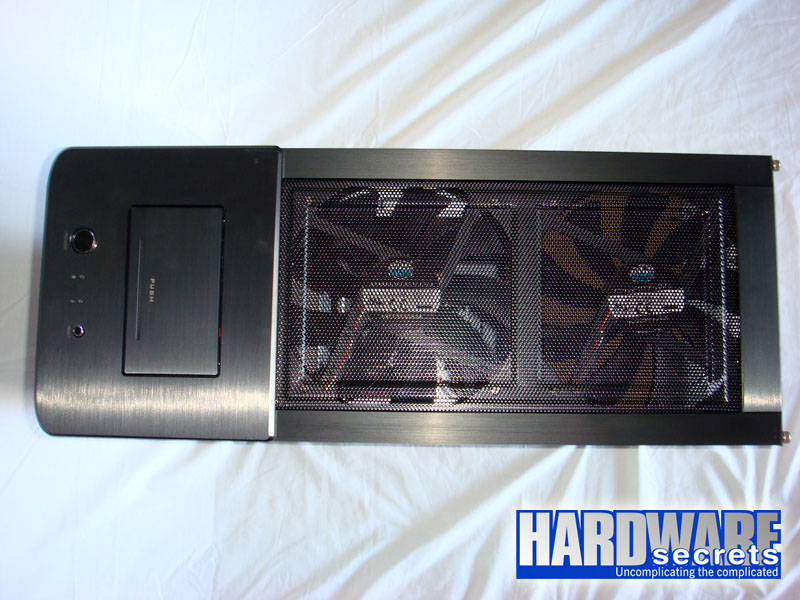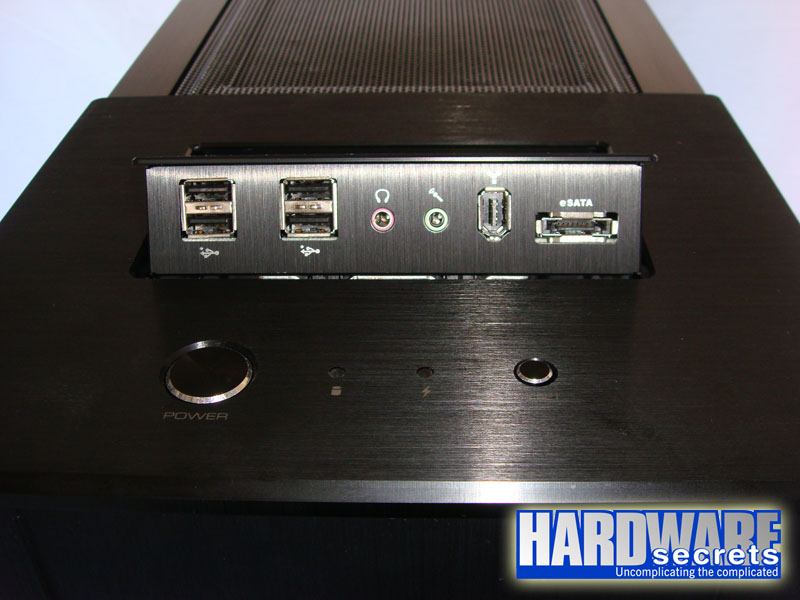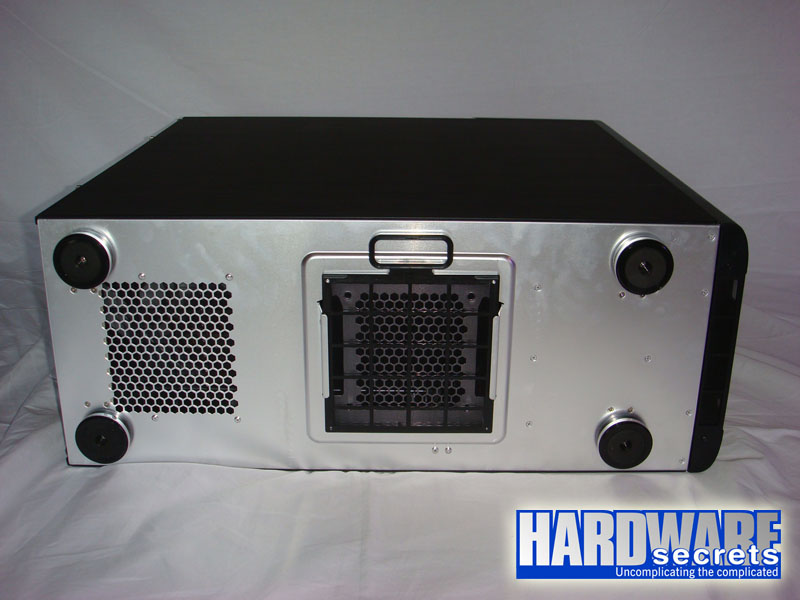[nextpage title=”Introduction”]
A while ago we reviewed Antec ISK300-65, which proved to be a nice mini ITX case. This other case, however, comes with an external power supply, with a DC-DC converter module inside the case to convert the 19 V provided by the external power supply into the voltages required by the PC (+12 V, +5 V, +3.3 V, etc). On the new ISK300-150, Antec added an internal 150 W power supply, which allows you to install a more powerful system. Let’s see if this new version is as good as the previous version.
In Figure 1, you can see the comparison between the ISK300-150 box with a standard mid-tower case box, while in Figure 2 you can see ISK300-150 compared to a mid-tower case. The difference in size is dramatic, making ISK300-150 a possible choice if you want to build the smallest computer in town.
Figure 1: Comparing ISK300-150 to a standard mid-tower case.
Figure 2: Comparing ISK300-150 to a standard mid-tower case.
ISK 300-150 has exactly the same size as ISK 300-65: 3 ¾” x 8 ¾” x 12 29/32” (9.6 cm x 22.2 cm x 32.8 cm). But since it has an internal power supply, it is 1 lbs (400 g) heavier than its little brother, moving from 7.5 lbs (3.4 kg) to 8.5 lbs (3.8 kg).
On Figures 3 and 4 you have an overall look from Antec ISK300-150.
Figure 3: Antec ISK300-150 case.
Figure 4: Antec ISK300-150 case.
Here we could spot a major difference between ISK300-150 and ISK300-65: the new version has left panel meshed using the same pattern as the one used on the right panel, while on ISK300-65 this panel is solid and only the right panel is meshed. Both have a mesh on the top panel above the area where a slim expansion card can be installed. Like ISK300-65, a triple-speed 80 mm fan is present on the right panel and there is a space for installing a second 80 mm fan there. We will talk more about cooling options later.
[nextpage title=”Introduction (Cont’d)”]
Of course to reduce its size ISK300-150 only supports slim optical drives, i.e., drives originally developed for portable computers. The only drawback is that this option increases the final cost of your computer, as slim drives are more expensive.
The front panel has a very sober and professional looks. The bay for the slim optical drive is protected by a cover, and ISK 300-150 has one eSATA port and two USB ports, plus the traditional microphone and headphones jacks. The additional of an eSATA port is an obvious plus.
The front panel of ISK300-150 is identical to the one used on ISK300-65.

Figure 5: Front panel.
In Figure 5, you can see the rear panel from the reviewed case. As you can see, the rear panel isn’t painted black. There is a rounded hole that on the ISK300-65 version is used to host the jack from the external power supply. Then we have an empty space for installing a fan controller for the second (optional) 80 mm fan and the three-speed switch for controlling the speed of the 80 mm fan that comes with the case. If you pay attention you will see “top” and “rear” written on the frame around these switches: to save money Antec used this part from another case instead of manufacturing a frame specifically designed for this case.
You can also see the power cord receptacle and the presence of only one expansion slot, which only supports slim expansion cards.
Also notice how the top cover is attached to the main chassis using silver thumbscrews.

Figure 6: Rear panel.
Antec ISK300-150 comes with a stand if you want to use your computer sideways, see Figure 7.

Figure 7: Installed sideways.
[nextpage title=”Inside ISK300-150″]
Now let’s take a look inside ISK300-150. On Figures 8 and 9 you have an overall look from its interior right after removing its top panel. The frame you see on the top part is where the disk drives are installed. On Figures 10 and 11 you see the interior of this case with this part removed.
Figure 8: Overall look.
Figure 9: Overall look.
The 150 W power supply that comes inside the case is installed on its front portion, where on ISK300-65 we have the DC-DC converter module. Therefore we didn’t lose a lot of space by having the power supply inside the case. Anyway, you can only install expansion cards up to 7” (180 mm) in length and CPU coolers up to 2.5” (6.5 cm) in height. And, as you may have already figured out, this case only holds mini ITX motherboards.
Figure 10: Overall look.
In Figure 11 you can better see the 80 mm fan that comes with the product. It is “TriCool DBB” model (“DBB” stands for Double Ball Bearing), providing three different speeds (low, medium and high), configured through the switch available on the rear panel. Since there is a place for installing a second switch on the rear panel, the second (optional) fan can be an identical “TriCool” fan. No information on the actual speeds, airflow or noise level is
available. This fan uses a standard peripheral power plug, so you can’t monitor its speed.
Figure 11: Overall look.
[nextpage title=”The Disk Drive Bays”]
This case has one external bay for slim optical drives and two internal 2.5” bay for hard disk drive or SSD units. The two 2.5” bays are located side by side on the front part of the case, on top of the available plate (piece on the left-hand side in Figure 13). Drives must be screwed from below and this plate is easily removed by unscrewing one thumbscrew. The slim optical drive bay is located on the compartment below the 2.5” bays (piece on the right-hand side in Figure 13). As you can see, 3.5” hard disk drives are not supported.
Figure 12: The disk drive bays.
Figure 13: The disk drive bays.
[nextpage title=”The Power Supply”]
In Figure 14 you have an overall look of the power supply that comes with ISK300-150, an Antec-braded 150 W model (FP-150-8). This unit features active PFC and automatic voltage selection.
The included power supply has the following cables:
- Main motherboard cable with a 20/24-pin connector (10” or 25 cm long).
- Cable with one ATX12V connector (13 3/8” or 34 cm long)
- One cable with two SATA power connectors and one miniature SATA power connector (10” or 25 cm to the first connector, 7 7/8” or 20 cm between connectors).
- One cable with two SATA power connectors (10” or 25 cm to the first connector, 7 7/8” or 20 cm between connectors).
- One cable with two standard peripheral power connector and one floppy disk drive power connector (10 ¼” or 26 cm to the first connector, 7 ½” or 19 cm between connectors).
All wires are 20 AWG, but being a 150 W product we really can’t complain.
Figure 14: 150 W power supply that comes with Antec ISK300-150.
Figure 15: 150 W power supply that comes with Antec ISK300-150.
Since we have the necessary equipment to make in-depth power supply tests, we decided to test the 150 W power supply that comes with ISK300-150 to see whether it is a good unit or not.
[nextpage title=”The Power Supply: Load Test”]
Please read our article Hardware Secrets Power Supply Test Methodology to understand our power supply testing methodology.
We tested this power supply with five different load patterns, trying to pull around 20%, 40%, 60%, 80%, and 100% of its labeled maximum capacity (actual percentage used listed under “% Max Load”), watching how the reviewed unit behaved under each load. In the table below we list the load patterns we used and the results for each load.
If you add all the power listed for each test, you may find a different value than what is posted under “Total” below. Since each output can vary slightly (e.g., the +5 V output working at +5.10 V), the actual total amount of power being delivered is slightly different than the calculated value. On the “Total” row we are using the real amount of power being delivered, as measured by our load tester.
The +12VA and +12VB inputs listed below are the two +12 V independent inputs from our load tester. During this test both inputs were connected to the power supply single rail (+12VB input was connected to the power supply ATX12V connector and all other cables were connected to the load tester +12VA input).
| Input | Test 1 | Test 2 | Test 3 | Test 4 | Test 5 |
| +12VA | 1 A (12 W) | 2 A (24 W) | 3 A (36 W) | 4 A (48 W) | 5.25 A (63 W) |
| +12VB | 1 A (12 W) | 1.5 A (18 W) | 2.75 A (33 W) | 4 A (48 W) | 5 A (60 W) |
| +5V | 1 A (5 W) | 1 A (5 W) | 1.5 A (7.5 W) | 1.5 A (7.5 W) | 2 A (10 W) |
| +3.3 V | 1 A (5 W) | 1 A (5 W) | 1.5 A (4.95 W) | 1.5 A (4.95 W) | 2 A (6.6 W) |
| +5VSB | 1 A (5 W) | 1 A (5 W) | 1 A (5 W) | 1 A (5 W) | 1 A (5 W) |
| -12 V | 0.5 A (6 W) | 0.5 A (6 W) | 0.5 A (6 W) | 0.5 A (6 W) | 0.5 A (6 W) |
| Total | 42.6 W | 59.9 W | 90.5 W | 116.0 W | 145.6 W |
| % Max Load | 28.4% | 39.9% | 60.3% | 77.3% | 97.1% |
| Room Temp. | 26.8° C | 29.6° C | 29.8° C | 30.2° C | 31.4° C |
| PSU Temp. | 26.9° C | 33.9° C | 34.2° C | 34.4° C | 35.6° C |
| Voltage Regulation | Pass | Pass | Pass | Pass | Pass |
| Ripple and Noise | Pass | Pass | Pass | Pass | Pass |
| AC Power | 66.5 W | 85.8 W | 124.2 W | 154.9 W | 193.1 W |
| Efficiency | 64.1% | 69.8% | 72.9% | 74.9% | 75.4% |
| AC Voltage | 116.9 V | 115.4 V | 115.4 V | 115.2 V | 114.8 V |
| Power Factor | 0.987 | 0.992 | 0.996 | 0.997 | 0.998 |
| Final Result | Pass | Pass | Pass | Pass | Pass |
The power supply from Antec ISK300-150 can really deliver 150 W, but it is important to notice that we relaxed on the room temperature, since this is a low-wattage model that is hard to heat.
The main problem with this power supply is efficiency: below 80% all the time.
Voltages were always within their allowed range and noise and ripple was always below the maximum allowed. You can see noise levels during test five below. The maximum allowed is 120 mV on +12 V and 50 mV on +5 V and +3.3 V. All numbers are peak-to-peak figures.
Figure 16: +12VA input from load tester at 145.6 W (54.4 mV).

Figure 17: +12VB input from load tester at 145.6 W (54.4 mV).
Figure 18: +5 V rail with power supply delivering 145.6 W (18.2 mV).
Figure 19: +3.3 V rail with power supply delivering 145.6 W (9.4 mV).
[nextpage title=”Main Specifications”]
Antec ISK300-150 case main specs include:
- Style: small form factor (SFF)
- Application: Mini ITX.
- Material: Zinc-coated steel (SECC).
- Power supply required: Antec FP-150-8 (150 W).
- Available colors: Black.
- Side panel: Meshed (right and left panels).
- Dimensions: 3 ¾” x 8 ¾” x 12 29/32” (9.6 cm x 22.2 cm x 32.8 cm)
- Net Weight: 8.5 lbs (3.8 Kg)
- Gross Weight: 10.5 lbs (4.8 Kg)
- Bays: One bay for slim optical drive, two internal 2.5” bays.
- Expansion slots: one (slim, a.k.a. half-height)
- Fans: One 80 mm TriCool DBB on right panel.
- Optional fans: One 80 mm on right panel.
- More Information: https://www.antec.com
- Average price in the US*: USD 100.00
* Researched at Newegg.com on the day we published this review.[nextpage title=”Conclusions”]
Antec ISK 300-150 is a small case targeted to users that want to build the smallest PC around. The main problem with this case is the power supply that comes with it, which provides a lousy efficiency below 80% all the time. Therefore we can’t recommend it.
Strong Points
- One of the smallest cases on the market today.
- Two 2.5” hard disk drive bays.
- Fan with speed control.
- eSATA port.
Weak Points
- No anti-vibration mechanisms for the hard disk drives.
- No screwless mechanisms for holding hard disk drives.
- The use of a slim optical drive increases the final cost of the computer.
- Lack of support for 3.5” hard disk drives can be a problem for some users
- Power supply has low efficiency (between 64.1% and 75.4% in our tests).
















Leave a Reply